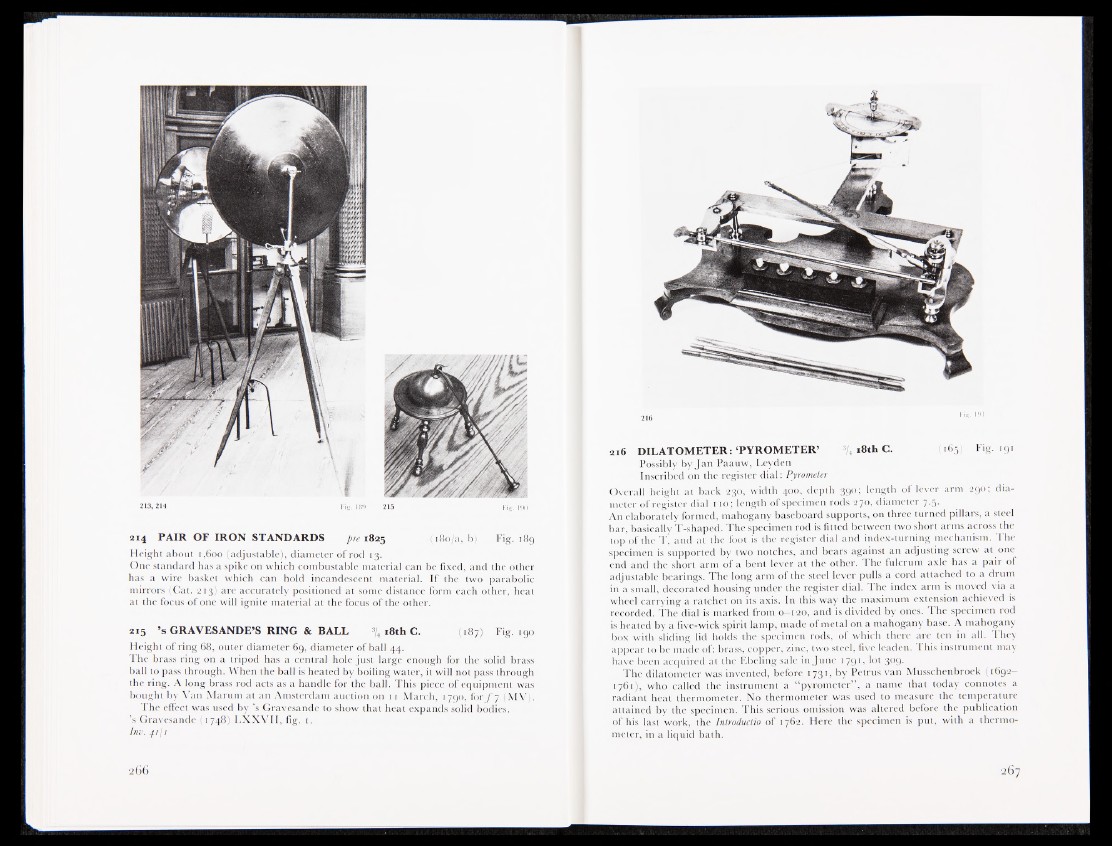
214 PAIR OF IRON STANDARDS pre 1825 (180/a, b) Fig. 189
Height about 1,600 (adjustable), diameter of rod 13.
One standard has a spike on which combustable material can be fixed, and the other
has a wire basket which can hold incandescent material. If the two parabolic
mirrors (Cat. 213) are accurately positioned at some distance form each other, heat
at the focus of one will ignite material at the focus of the other. 215
215 ’s GRAVESANDE’S RING & BALL \ 18th C. (187) Fig. 190
Height of ring 68, outer diameter 69, diameter of ball 44.
The brass ring on a tripod has a central hole just large enough for the solid brass
ball to pass through. When the ball is heated by boiling water, it will not pass through
the ring. A long brass rod acts as a handle for the ball. This piece of equipment was
bought by Van Marum at an Amsterdam auction on 11 March, 1790, for ƒ 7 (MVH
The effect was used b y ’s Gravesande to show that heat expands solid bodies.
’s Gravesande (1748) LXXVII, fig. 1.
Inv. 4111
216 DILATOMETER:‘PYROMETER’ 3/+ 18th C. (165) Fig. 191
Possibly by Jan Paauw, Leyden
Inscribed on the register dial: Pyrometer
Overall height at back 230, width 400, depth 390; length of lever arm 290; diameter
of register dial 110; length of specimen rods 270, diameter 7.5.
An elaborately formed, mahogany baseboard supports, on three turned pillars, a steel
bar, basically T-shaped. The specimen rod is fitted between two short arms across the
top of the T, and at the foot is the register dial and index-turning mechanism. The
specimen is supported by two notches, and bears against an adjusting screw at one
end and the short arm of a bent lever at the other. The fulcrum axle has a pair of
adjustable bearings. The long arm of the steel lever pulls a cord attached to a drum
in a small, decorated housing under the register dial. The index arm is moved via a
wheel carrying a ratchet on its axis. In this way the maximum extension achieved is
recorded. The dial is marked from 0-120, and is divided by ones. The specimen rod
is heated by a five-wick spirit lamp, made of metal on a mahogany base. A mahogany
box with sliding lid holds the specimen rods, of which there are ten in all. They
appear to be made of: brass, copper, zinc, two steel, five leaden. This instrument may
have been acquired at the Ebcling sale in June 1791, lot 309.
The dilatometer was invented, before 1731, by Petrus van Musschenbroek (1692—
i76i|giwho called the instrument a “pyrometer” , a name that today connotes a
radiant heat thermometer. No thermometer was used to measure the temperatuie
attained by the specimen. This serious omission was altered before the publication
of his last work, the Introductio of 1762. Here the specimen is put, with a thermometer,
in a liquid bath.